
views
Choosing the Right Cream for Your Shoes
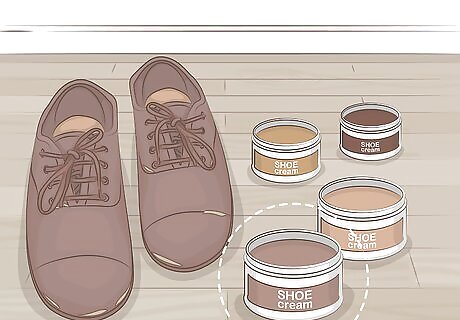
Match the color of your shoes as closely as possible. Shoe cream comes in a variety of colors, including white or neutral, black, various shades of brown, and even a range of less natural colors (such as blue, red, green, or yellow). While you’re unlikely to find a polish that’s the exact same shade as your shoes, it’s a good idea to choose one that more or less matches.Tip: If you choose a polish that’s not a good match for your shoes, don’t fret too much. It can be cleaned off. For example, if you’re polishing brown shoes, choose a brown polish in a similar shade. Don’t use black polish on a brown shoe. Most shoe creams only add a subtle hint of color, which builds up over time with repeated uses. High-quality shoe cream has more color pigment than lower quality brands.

Opt for a neutral shoe cream if you don’t want to add much color. While most shoe creams are tinted, many brands offer neutral options that add little or no color. These are a good option if you like the soft texture and matte finish of shoe cream, but aren’t interested in tinting your shoes. Some shoe experts recommend using only neutral creams or polishes on brown dress shoes, especially if they’re burnished.
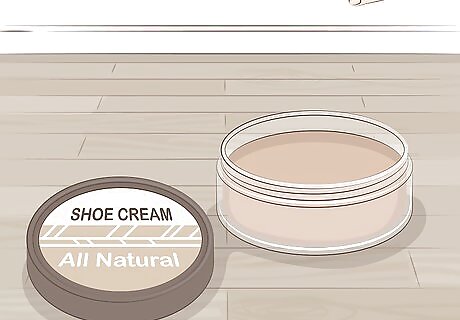
Choose an all-natural formula for the maximum benefits to your leather. Most leather absorbs natural oils and waxes more easily than synthetic ones, and natural formulations will leave your leather in better condition. Look for an all-natural shoe cream if you want to keep your shoes in the best possible condition, especially if they are made of high-quality full-grain leather. The disadvantage of all-natural creams is that they tend to be more expensive than synthetic or partly synthetic alternatives. Avoid using pure shoe wax on leather since it could actually damage the material over time. If you’re on a budget, look for a high-quality partly synthetic cream polish, such as Meltonian or Kiwi.
Cleaning Your Shoes

Remove the laces from your shoes. Before you start cleaning and polishing your shoes, take the laces out (if your shoes have them). This will both protect your laces and make it easier for you to do a thorough cleaning and polishing job.Tip: If your shoes have leather laces, they will also need special care to keep them soft, clean, and in good condition. This is a good time to clean them!
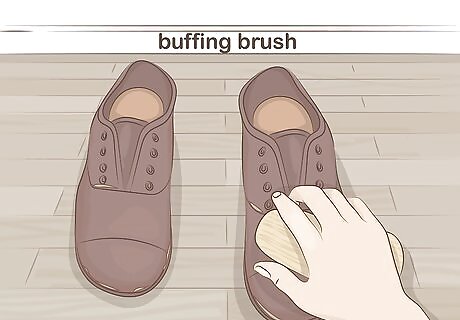
Buff off any loose dirt with a buffing brush. While your shoes are still dry, gently buff the surface to brush away dust, grime, and dirt. A basic horsehair shoeshine brush will work well for this purpose. For buffing and polishing, use a wide, handleless shoe brush. You can also get dauber brushes (small, round brushes with handles) for more detailed work.
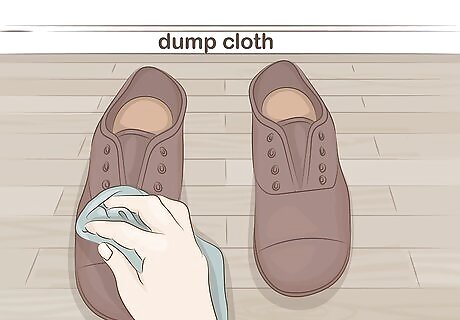
Wipe the shoes with a damp cloth to remove any remaining dirt. Once you’ve buffed your shoes, grab a clean, soft cloth and dampen it with a little water. Gently wipe the surface of the shoes to clean away any remaining dust and grime. The cloth doesn’t have to be anything special. In fact, a rag cut from an old t-shirt will do the job nicely. Let the shoes dry before you apply any conditioner or polish.
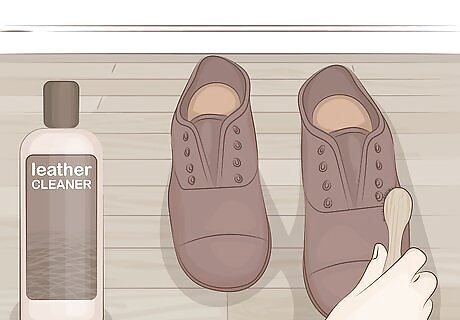
Wash the shoes with a leather cleaner if there’s any polish buildup. If your shoes are very dirty or you notice a buildup of old polish, you’ll need to use more than just water to clean them. Put a small amount of leather cleaner on a damp cloth or dauber brush and work it over the shoes using circular motions. Wipe away the lather with a clean, soft cloth. Use a gentle, pH balanced leather cleaner such as Lexol or saddle soap. Don’t use any soap or cleanser that isn’t designed for use with leather. Regular soaps or detergents could dry out and damage your shoes.
Applying the Shoe Cream
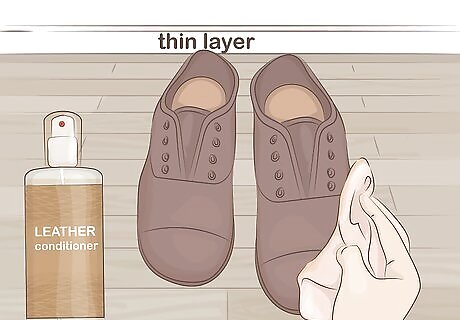
Rub in a thin layer of leather conditioner with a soft cloth. Once your shoes are clean, grab a fresh cloth and apply a little conditioner to your shoes. This will help keep the leather moisturized and supple and prevent cracks from forming. You don’t need to use a lot—just enough to add a light sheen. Leather conditioners can come in a variety of forms, including resins and sprays.
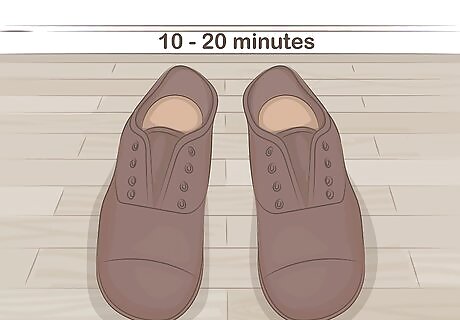
Let the conditioner soak in for 10-20 minutes. Before you add any shoe cream, give the conditioner a chance to work. Set your shoes aside for 10-20 minutes and check on them to make sure they are dry and the conditioner is completely absorbed. If you’re polishing multiple shoes, you can work on the next pair while you wait.
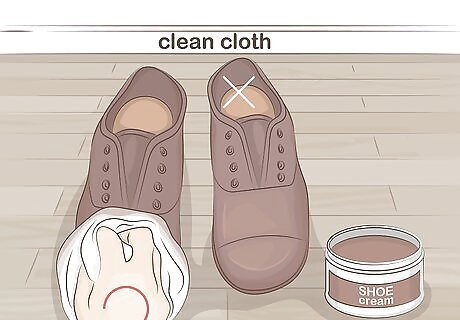
Apply the shoe cream in a circular motion with a clean, soft cloth. Get a soft cloth, such as a rag cut from an old T-shirt, and use it to pick up a little shoe cream. Rub the cream over the entire upper surface of the shoes, using circular motions. Don’t apply cream to the soles or the insides of your shoes, only to the exterior leather surfaces. Take care not to apply so much polish that it looks streaky or gummy or builds up in the creases of the shoes—you just need to add a thin sheen. If you think your shoe could use more polish after the first layer, go over it again a second time. As an alternative to a soft cloth, you can apply the polish with a dauber brush. While you may need to do it more or less often depending on how much you wear your shoes, in general it’s a good idea to apply shoe cream once a month.
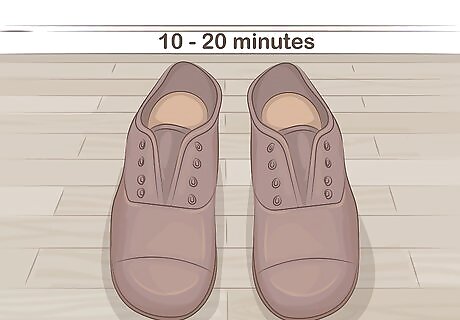
Allow the cream polish to dry for 10-20 minutes. When you first apply the cream, it will be a little wet and sticky. Set the shoes aside to let them dry for a while before you move on to the next part of the polishing process. If you’re polishing multiple shoes, now is a good time to move on to the next pair.
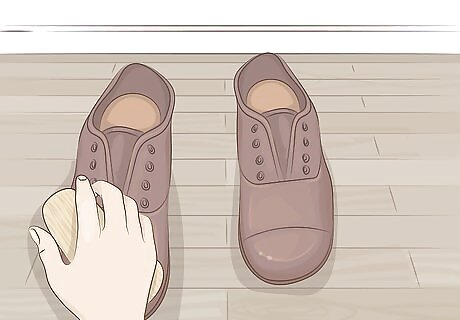
Buff the shoes with a shoe brush. After the cream dries, vigorously rub the shoes with your shoe brush to help work the polish more deeply into the leather. This will also add extra shine and help remove any excess residue. Use quick, side-to-side strokes to buff the entire shoe until you achieve a subtle shine all over. A horsehair brush will work well for this purpose. After you finish buffing your shoes, they should have a soft, matte shine.

Add a layer of wax polish if you want extra shine. If you’d like your shoes to look a little glossier or more highly polished, go over your shoes again with some colorless wax polish. Wax polish is designed to add shine without contributing any additional color. Tip: For ultra-shiny shoes, try a spit shine. After applying the wax, put a little water (or spit, if you want a truly traditional spit shine) on a soft cloth and use it to dampen the shoes. Then add another layer of wax polish to the shoes, rubbing it in using circular motions. Once you’ve applied the wax polish with a cloth or brush, rub your shoes with a soft chamois cloth to give them a perfect shine.


















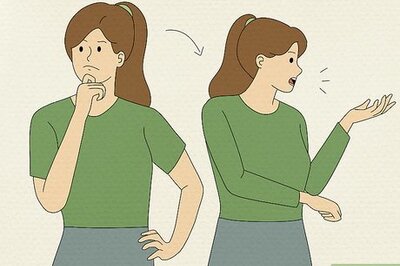
Comments
0 comment